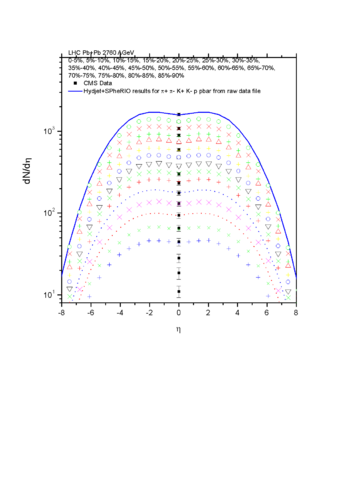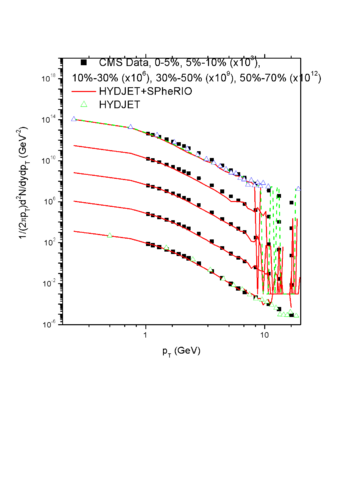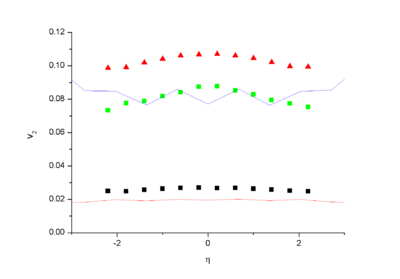Hydjet + SPheRIO results
Initial Conditions
- How are they defined?
The initial condition (IC) are determined by the wounded nucleon model, which is independent of HYDJET. The wounded ncleon (Glauber) model first calculates the (density of) number of participants as a function of coordinates on the transverse plane <math>N_{part}(x,y)</math>, and the energy density is set to be proportional to this number. The proportional constant is determined by the particle yields, namely, <math>\frac{dN_{ch}}{d\eta}</math>. For Pb nucleus, I have used the parameters as discussed in the Phobos MC Glauber paper. The size of the tube is <math>r_t=0.5 \text{fm}</math> and the energy of the tube is <math>20 \text{MeV}</math> each.
- How can they be changed?
As long as there is a (microscopic) model which calculates energy density in hyperbolic coordinates <math>(\tau,x,y,\eta)</math>, we can change the the value of energy momentum tensor defined in SPheRIO as described in the manual of SPheRIO.
- How IC are introduced in SPheRIO?
As any hydrodynamic model, IC are defined in terms of the energy momentum tensor, which contains, automatically, information on pressure, energy density and viscosity. In the case of SPheRIO, only energy density is necessary since one uses an equation of state (EoS) and ignores viscosity. But it has to be defined in the hyperbolic coordinates, or some transformation is required.
- SPheRIO implementation: a table is enough?
Yes indeed, the convention is defined in the head file "epos.incso" as well as briefly in the manual.
Plots of IC
Note, in some of the IC, I did not implemented the twist in longitudinal (<math>eta</math>) direction, though most of them. It is proposed by Hirano which can be found at this link here. One may click on each icon to get the original size of the corresponding plot.
Current status
- Multiplicity plots
We have calculated <math>\frac{dN_{ch}}{d\eta}</math> and <math>\frac{d^2N_{ch}}{2\pi p_Tdp_T\Delta y}</math> for different central windows.
I made a mistake to fit the multiplicity data first, only to find out the flow is not good. The condor system is not quite stable, there is around 2-4% of chance for an event to fail, so for a total of 5000+ events, 15+ events will fail, when this happens, condor will hold all other events to wait for this event to finish. One weak link is that the condor system does not inform why it failures, so if it was due to a programming mistake, the unlucky user has to figure this out by themselves. After debugging the script, I modified the script to skip the those events that has been successfully calculated so that I need only to run the same script again, given the first run fails, and in principle the script only has to deal with those failed events. Unfortunately, I was only left to find out that condor still has a good chance to fail those events even when the script only checks and eventually skips the calculation. So the sometimes calculation never moves forward. The current version of script work well if one calculates 100+ events each time, since one can choose to manually download the data file to a local computer for further analysis (at any instance), unfortunately, it is too expensive when one has to calculate flow using 5000+ events for each centrality window. In the following, I attached a portion of the script used by me and Danuce, it works well for 100+ events but it does not work efficiently for 5000+ events. For more detail, please check out this summary.
- Initial Conditions generated by wounded nucleon model
- Flow
The flow can be adjusted by the size of the tubes and the total number of the tubes (while the other parameter left, namely, the energy of the tube, is determined by the multiplicity normalization). Increase of the total number of tubes will effectively reduce the fluctuation, therefore suppress the magnitude of elliptic flow. On the other hand, bigger size of tube tends to smear out and smooth out internal structures, therefore leads to smaller elliptic flow.
The preliminary results on calculated flow are obtained by tuning above parameters. Calculations were mostly done at the most central window (0 - 5%) and most peripheral window (50% - 60%). However, at big centrality, the current result underestimate the data for 3D calculation, it overestimate the data for 2D calculation with Bjorken scaling. Some check is needed to exclude any overlook in the implementation.
- Initial Conditions generated by wounded nucleon model
In the plots, the triangular symbols are the elliptic flow data for 50 - 60%, the green symbols are for 20% - 25% and black squares are for 0 -5%. The curves were calculated by HYDJET+SPheRIO 3D evolution for two centrality windows 0 - 5% (red) and 50% - 60% (blue), the green curve is obtained for 50% - 60% but using a 2D evolution with Bjorken scaling.

















































